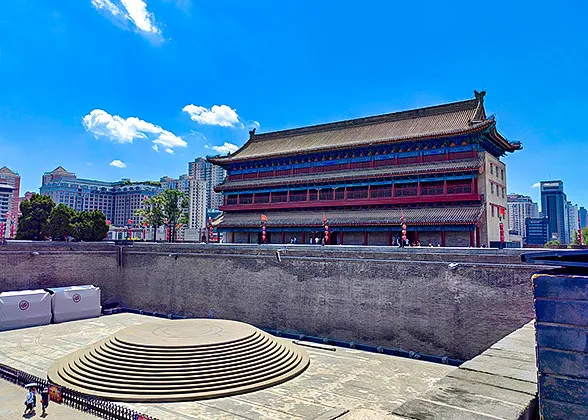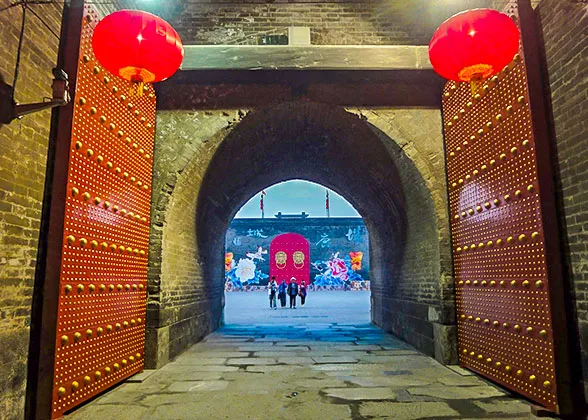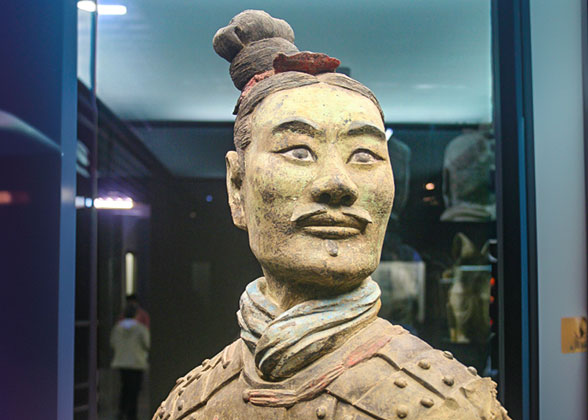Fortifications of Xi’an - Defensive System of City Wall
Xi’an City Wall was built from 1370 to 1378 in Ming Dynasty (1368-1644), and has long been a strong defensive building to surround the whole city area and protect people in the city. In peacetime, it functions as a boundary, while in wartime, its complete military facilities defend against outside attacks and provide safety guard.
The First Defensive Line - Moat
All around the City Wall is the outermost defensive line - a wide and deep moat. Over the years, its function has remained the same, to prevent the enemy from directly approaching city gates and make time for deploying more solders to support.
The Second Defensive Line - Drawbridge and Drawbridge Tower
Above the moat, drawbridges are constructed as the only ways to the city. They are usually lowered for people to enter or exit the city. When the enemy attacks, they are raised and all the passages to the city are cut off, effectively resisting the enemy.
Behind the drawbridge stands the building to control its raising and lowering. A total of 12 arrow-shooting windows in two rows and six columns are neatly arranged on its front surface, and its western and eastern surface each have 4 arrow-shooting windows, so that solders can be on the watch for the enemy and timely attack back. Moreover, the drawbridge building can further be deployed with firearms and artillery, to block enemies’ entrance to the city.
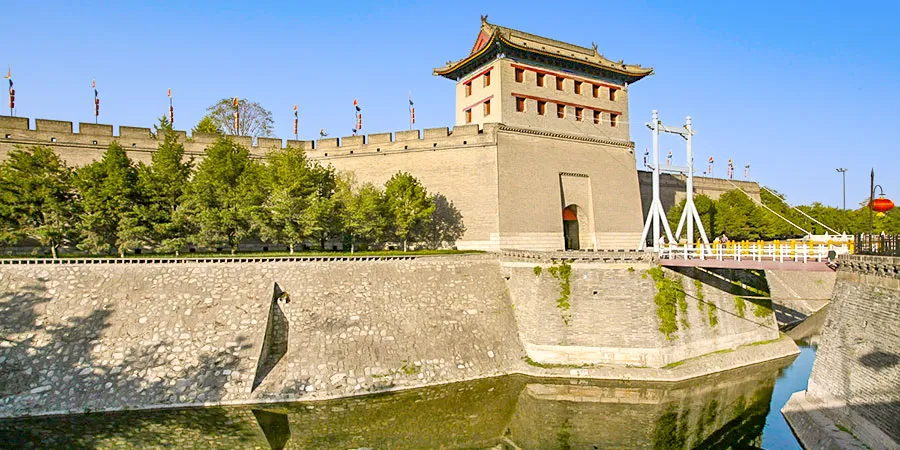
The Third Defensive Line - Crescent-shaped Enclosure
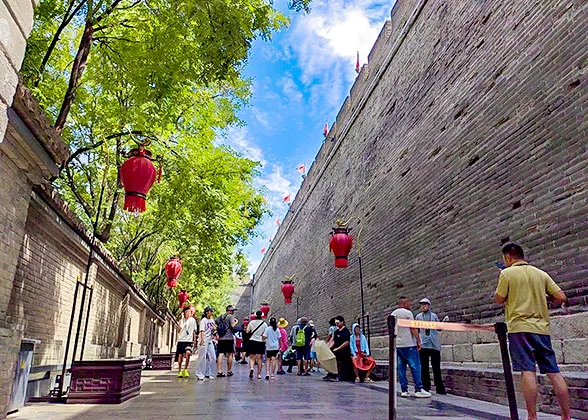 |
| Passageway of Crescent-shaped Enclosure |
The Fourth Defensive Line - Arrow-shooting Tower
The grand arrow-shooting tower behind the crescent-shaped enclosure inspires people’s shock and awe. With a height of nearly 20 meters (22 yards), this building features a lookout function, and 48 arrow-shooting windows in 4 rows are opened in the front and 9 arrow-shooting windows in 3 rows are opened on each side. When the enemy enters the crescent-shaped enclosure, plenty of arrows are shot all at once, forming dense attacks. The design of the window is larger on the outside, making the range of shooting wider.
 |
| Tourists in front of Arrow-Shooting Tower |
The Fifth Defensive Line - Barbican
Even enemies break through archers’ intensive shooting, much more violent attacks await them. Through the doorways, they enter the 65-meter-long (71 yards) and 48-meter-wide (52 yards) barbican, which is enclosed by the back wall of the arrowing-shooting tower, the front side of the city gate, and two walls on eastern and western sides. With all the gates closed, the barbican confines the enemy. Meanwhile, solders on the wall occupy a superior position and take offensives into the barbican.
|
|
The Sixth Defensive Line - City Gate
The last defensive line of the city is also quite sturdy, and that’s the wooden city gate with a thickness of about 16 centimeters (6.5 inches). City gates are regarded as the relatively weak part of the city’s defensive system, and once they are lost, the whole city is in a dangerous situation. Many battles in the history have been fought on the control of city gates.
Based on this, city gates of Xi’an City Wall are constructed to be quite solid in terms of appearance, material, and structure. The 3-ton-heavy thick gate is further strengthened by steel strips 9 to 15 centimeters (3.5 to 6 inches) wide and hundreds of studs, and this type of design increases sturdiness of the gate and makes it hard for arrows to pierce through. The gateway is constructed with bricks and it tapers outward, reserving more combat space for soldiers in the city.
Other Defensive Facilities of Xi’an City Wall
1. Rampart and Watchtowers
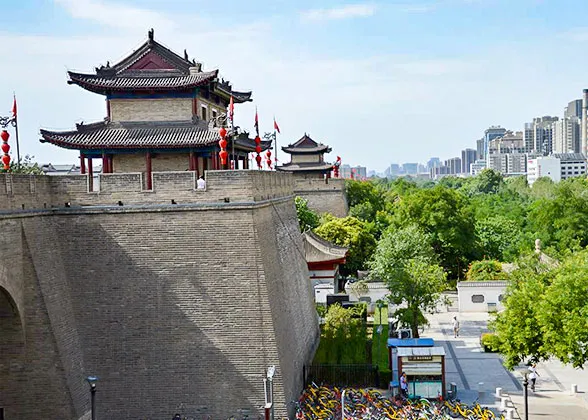 Every 120 meters (130 yards) all along the City Wall, a rampart protruding from the outer surface of the wall is built. It also has a name of a “horse face” due to its upward narrowing structure. The reasons why two ramparts have a distance of 120 meters are that the maximum effective range for an archer is 60 meters (65 yards), and the distance needs to ensure there is no blind spot in the shooting area. A total of 98 ramparts are built, enabling soldiers to protect the city all round. On each rampart is a watchtower for observation and signaling.
Every 120 meters (130 yards) all along the City Wall, a rampart protruding from the outer surface of the wall is built. It also has a name of a “horse face” due to its upward narrowing structure. The reasons why two ramparts have a distance of 120 meters are that the maximum effective range for an archer is 60 meters (65 yards), and the distance needs to ensure there is no blind spot in the shooting area. A total of 98 ramparts are built, enabling soldiers to protect the city all round. On each rampart is a watchtower for observation and signaling.2. Corner Towers
The corner tower enjoys a greater height and a wider observation angle compared with the watchtower, making it more convenient to look out for the enemy. Standing on the corner towers, soldiers can flexibly and effectively support ones on the wall on both sides. Besides, the corner tower can further serve as a weapon store.
3. Battlements
Battlements constructed on the outer side are much higher than the wall on the inner side, and they are marked with spaced crenels for archers to shoot and merlons for hiding and observing the enemy. On the entire City Wall, there are totally 5,984 battlements.
Where to View the Most Complete Fortifications of Xi’an City Wall?
Among four main gates of Xi’an City Wall, the South Gate / Yongning Gate has fortifications in a full scale and becomes the best place to learn about the defensive system.
 Further Reading:
Further Reading:
How to Visit Xi'an City Wall
8 Amazing Facts about Xi’an City Wall
How to Visit Xi'an City Wall
8 Amazing Facts about Xi’an City Wall
Recommended Tours
- Last updated on Sep. 17, 2025 by Alex Jin -
